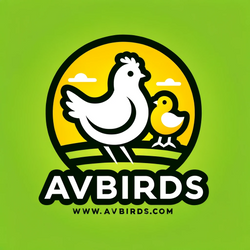Introduction
The first twelve weeks of a turkey poult’s life define its long-term health, size, and productivity. Proper nutrition prevents leg deformities, rapid mortality, and slow growth. Whether you’re raising Bourbon Red or Royal Palm turkeys, this comprehensive feeding guide from AV Birds outlines what, when, and how much to feed from hatch to 12 weeks.
1. Feed Basics for Poults
Turkey poults grow twice as fast as chickens and require higher protein and niacin levels. Ordinary chick starter feed is insufficient.
Recommended Starter Feed Specs:
-
Protein: 28 %
-
Niacin: 55–65 mg/kg
-
Crude Fat: 2–4 %
-
Fiber: ≤ 5 %
Use game bird starter feed formulated for turkeys. Always serve feed fresh and dry.
(External link: University of Kentucky – Poultry Feed Guide)
2. Feeding Schedule (Weeks 1–12)
| Age | Feed Type | Protein % | Notes |
|---|---|---|---|
| 0–4 weeks | Game bird starter | 28 % | Free-choice feed, small crumbles |
| 5–8 weeks | Grower feed | 26 % | Introduce larger pellets |
| 9–12 weeks | Developer feed | 22–24 % | Add greens, grit |
Feed constantly (24 hours a day under light) for the first week. Transition to 12 hours light / 12 hours dark by week 4.
3. Water and Electrolytes
Clean water is as vital as feed. Each poult drinks ≈ 0.5 cups daily in week 1, increasing to 1–2 cups by week 12.
Add electrolytes and vitamins to water for the first five days after hatch to boost hydration and immunity.
(External link: Mississippi State Extension – Poultry Water Management)
4. Niacin Supplementation
Niacin deficiency causes leg and joint issues in poults.
If using generic feed, supplement with Brewer’s Yeast (2 Tbsp per pound of feed) or a vitamin mix containing niacin.
5. Feeding Environment
-
Keep feeders at back height of poults to reduce waste.
-
Use a 1-inch feeder space per poult (min. 2 feeders per 25 birds).
-
Protect feed from moisture and rodents.
6. Transition to Pasture Feeding
At ≈ 6 weeks, gradually introduce pasture greens (clover, dandelion, alfalfa).
Provide insoluble grit for digestion. By week 10, foraging can replace 10–20 % of their feed.
7. Signs of Proper Growth
-
Week 4: 0.5 lb
-
Week 8: 2 lb
-
Week 12: 5 lb (hen) / 6 lb (tom)
Healthy poults are active, smooth-feathered, and bright-eyed.
8. Common Feeding Mistakes to Avoid
| Mistake | Result | Solution |
|---|---|---|
| Feeding chick starter | Niacin deficiency | Use turkey/game bird feed |
| Wet feed | Bacteria & mold | Keep dry & clean feeders |
| No grit on pasture | Poor digestion | Provide small grit |
| Low protein | Slow growth | Follow 28 → 24 % schedule |
9. Why Buy Healthy Poults from AV Birds
Our Bourbon Red, Royal Palm, and Slate poults are raised on high-protein, vitamin-enriched feed for optimal growth and vitality. When you start with AV Birds heritage stock, you’re starting with health and quality.
(Internal link: Shop Turkey Poults Online)
Conclusion
Proper feeding is the difference between ordinary and extraordinary growth. Follow this plan to raise strong heritage turkeys ready for breeding or market by fall. For premium feed recommendations and healthy starter poults, visit AVBirds.com today.
